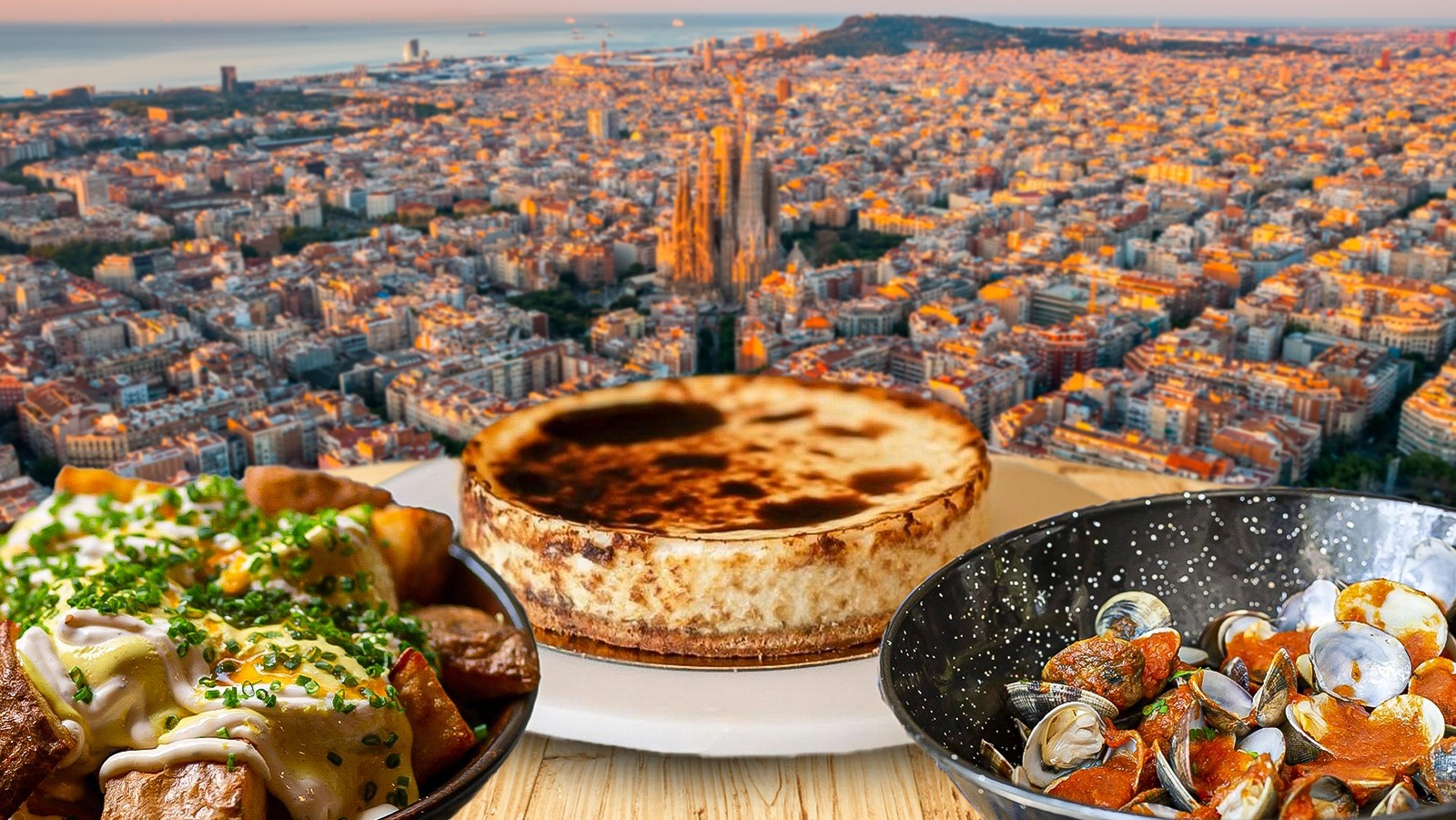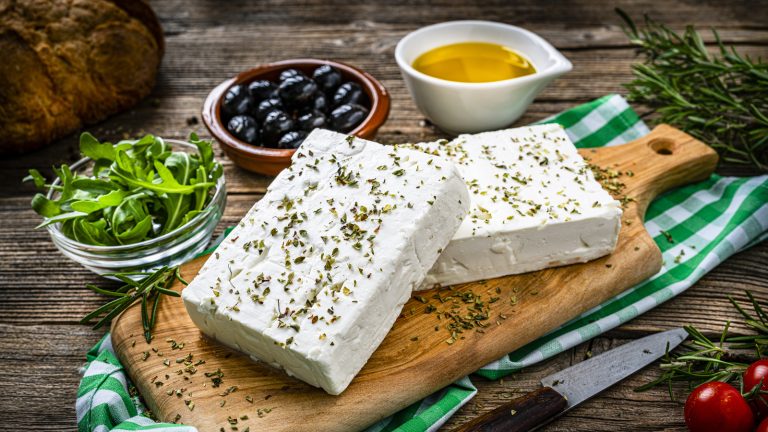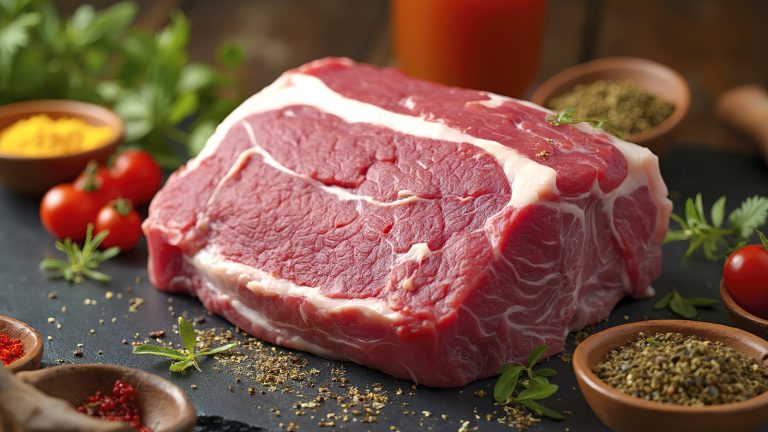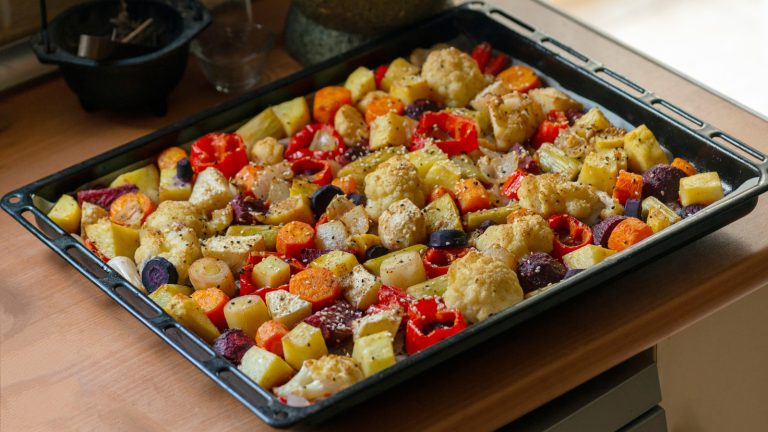Along with its lively streets, sun-kissed beaches, and stunning architecture, Barcelona’s vibrant food scene is part of what makes it such a popular tourist destination. The cosmopolitan Catalan capital is brimming with culinary variety. Traditional Catalan and Spanish delicacies are offered one door down from innovative modern reimaginings of those classics, fresh seafood is served straight from the Mediterranean Sea, and you can find almost every cuisine you can think of. Not only that — it’s also home to numerous Michelin-starred restaurants, including Disfrutar, which claimed the title of World’s Best Restaurant in 2024.
There are countless culinary delights to enjoy in Barcelona’s many restaurants. In this article, I’ve put together my personal favorite bites from Barcelona, drawing on my experience living and dining out in the city, and from training as a chef at a nearby culinary school. A longer explanation of the methodology used can be found at the end of the article. My aim is to highlight the culinary variety available in Barcelona, while providing some more context about each dish and the establishment that serves it.
Pastelería Hofmann’s mascarpone croissant
The name Hofmann is something of an institution in Barcelona, with a prestigious culinary school and a Michelin-starred restaurant to their name, as well as two pastelerías, or pastry shops. The pastelerías, one of which is in Barcelona’s central El Born neighborhood, are a delight for the senses, with creative, intricately designed cakes and sweet treats that are so pretty it’s almost a shame to eat them.
However, it’s the pastries that I keep coming back for, especially the spot’s croissant recipe, filled with generous amounts of rich mascarpone and glazed in a light, crisp layer of sugar. If mascarpone isn’t your thing, they have others filled with raspberry or almond paste, as well as occasional specials and seasonal items. Get a croissant and a coffee and wander around El Born’s narrow, quirky streets: It’s an indulgent but near-perfect way to start a day in Barcelona.
hofmannpasteleria.com
Multiple locations
Cava and charcuterie at Can Paixano
Known locally as El Xampanyeria, or the champagne bar, Can Paixano has earned its reputation as one of central Barcelona’s classic bar experiences. True to its nickname, here it’s (almost) all about Champagne’s sister drink, cava: Can Paixano serves up delicious, very reasonably-priced cava in special coupe glasses, along with an equally reasonably-priced range of sausages and grilled meats served in crusty bread. The food is no-frills but offers a perfect balance to the dangerously drinkable cava, and it’s not uncommon to see the small bar room at Can Paixano packed with locals and tourists alike from the moment it opens at midday.
Can Paixano’s popularity means you’ll most likely eat and drink while standing shoulder-to-shoulder at the bar with other customers, but that’s all part of the experience, and the bustling atmosphere makes for an exciting way to immerse yourself in one of the city center’s more affordable and authentic food experiences. My go-to is xistorra, a small spiced sausage similar in taste to chorizo, served in toasted crusty bread, with a couple of glasses of the sweet rosé cava to wash it down.
canpaixano.com
(+34) 933 100 839
Carrer de la Reina Cristina 7, Barceloneta, 08003 Barcelona
Bacon cheese naan and quality Indian street food at Mirch
Barcelona’s food scene is defined by its culinary variety, and the prevalence of restaurants offering fusion cuisine is testament to the multicultural nature of many of the city’s restaurants. One example is Mirch, in the Raval district of Barcelona, which styles itself as an Indian garrito. Mirch offers a menu of delicious Indian street food and curries with the occasional subtle Spanish detail giving a fresh twist to some all-out classics. One such innovation is its bacon cheese naan, which makes use of hearty naan as a vessel for Spanish flavor. It works wonderfully as an accompaniment to one of their more traditional curries, with a glass of verdejo white wine to keep the Indian-Iberian theme going strong. Also, the butter chicken pav is an unforgettably decadent, messy treat.
It’s not only the food that makes Mirch worth a visit. The decor and branding make for a fun atmosphere, and its location in one of Barcelona’s more lively (or noisy, depending on your perspective) neighborhoods makes it an ideal spot to grab a bite before disappearing into one of Raval’s many excellent bars for a nightcap.
mirchbarcelona.com
(+34) 934 586 985
Carrer dels Àngels, 12, Ciutat Vella, 08001 Barcelona
The bomba de la Barceloneta at Bar Leo
The seaside neighborhood of Barceloneta is a busy, idiosyncratic area brimming with tourists going to or from the beaches throughout the summer, but beneath the hustle and bustle lie some true culinary gems which offer another reason to visit the area. One of these is Bar Leo. A pilgrimage spot for flamenco and rumba artists, Leocadia Montes has been running this characterful little bar for nearly 40 years, and it continues to be a proudly family-run business.
Among Bar Leo’s menu of classic tapas like chicken croquetas and salt cod fritters is the bomba de la Barceloneta, or the Barceloneta bomb, a kind of giant croqueta ball filled with potato puree, ground meat, and sauce. As its name suggests, the bomba de la Barceloneta was first invented in the Barceloneta neighborhood in the 1950s, and supposedly got its name from the response of one of the first people to try it: “This is the bomb!” Since then, numerous establishments in Barceloneta, elsewhere in Barcelona, and even further afield in Spain have begun serving the popular tapas, usually accompanied by a spicy bravas-style tomato sauce and aioli.
instagram.com/barleobarceloneta
Carrer de Sant Carles, 34, Ciutat Vella, 08003 Barcelona
A cantabrian anchovy and its crispy spine at Jai-Ca
Just a five-minute walk from Bar Leo is another Barceloneta tapas bar well worth visiting: Bar Jai-Ca. Open since 1955, Jai-Ca offers an extensive tapas menu, but in keeping with its location in the old fisherman’s neighborhood, the focus is undoubtedly seafood. It’s worthwhile getting a selection of plates, some of which are conveniently available in half, so you can try as many different things as possible.
One adventurous dish which stands out on Jai-Ca’s menu is the bar’s own spin on a classic: An anchovy, served along with its fried fishbone. This dish is one big, salty anchovy fillet from the Cantabrian Sea — supposedly where the best anchovies in Spain come from — served alongside its spine, which has been cleaned, lightly battered in flour, and then fried. The idea of eating a spine might not sound appealing; however, the bones of the fish are so small that once fried, they become a crunchy, crispy delight that’s surprisingly appealing. I like to wrap the salty anchovy around the crispy spine and eat the two together, one little nibble at a time, to prevent the saltiness from becoming overwhelming. You could even try the spot’s house vermouth alongside, but take caution: It’s mixed with plenty of gin as well as soda and bitters, making it closer to a potent cocktail than a light drink!
barjaica.com
(+34) 933 19 91 64
Carrer de Ginebra 13 & 9, Ciutat Vella, 08003 Barcelona
Small plates and wine at L’Ànima del Vi
Good wine makes tapas taste even better; at least, that’s certainly the belief at L’Ànima del Vi in El Born. This cozy wine bar is brimming with personality and has walls lined with shelves full of wine bottles, each bottle with its price written on it in white marker. Run by French-Catalan couple Benoît Valée and Nuria Rodriguez Maymo, who share a deep knowledge and passion for wine, the bar specializes in natural wines, and the owners are well-informed about every bottle in their extensive collection.
L’Ànima del Vi offers a selection of French small plates which perfectly complement the wonderful wines it has available. These are written on the blackboard each day. You can ask whichever of the owners is there that day for a wine recommendation, or pick a bottle off the wall that catches your eye and ask for them to surprise you with a few plates they think will accompany it well. My personal favorite is the goose rillette served with some rustic toast to spread it on and, of course, crunchy cornichons.
lanimadelvi.com
Carrer dels Vigatans 8, 08003 Barcelona
Fresh seafood at La Paradeta or El Puertecillo
With various locations around the city, these two restaurants share the same unique concept. Part fishmonger, part restaurant, customers choose what they want from the day’s catch, which is laid out on ice on a counter. It’s cooked simply and expertly, topped with a splash of garlic and parsley oil or another simple sauce, and served up to you on a red plastic tray. It’s no-frills, great seafood at a reasonable price — and both restaurants are equally good at what they do.
When choosing what to go for at La Paradeta or El Puertecillo, I like to see what’s there and go with what looks best on the day. It’s hard to resist a handful of small, sweet scallops, which come served in their shells and hold plenty of juice to mop up with a miniature baguette. Each also offers homemade aioli which is very garlicky and utterly delicious with practically any seafood. However, it’s the fresh tuna that I reorder every time. I ask them to cut a good thick slab, and have it quick-seared on the grill so that each bite offers a variety of textures and flavors.
puertecillo.es
Multiple locations
laparadeta.com
Multiple locations
Calçots with salvitxada at a calçotada
Calçots are a Catalan delicacy that everyone should try at least once. However, if you’re going to get your hands on them you’ll need to be in Catalonia between December and March, since they’re a seasonal treat that’s mainly enjoyed in the winter. A calçot is a type of onion that’s somewhere between a scallion and a leek in size and flavor. They’re an important part of Catalan culinary culture, and are enthusiastically eaten at celebrations called calçotadas. Large numbers of calçots are flame-grilled over an open fire until they’re blackened before being wrapped in newspaper, which effectively steams and softens them. Then they’re served — somewhat strangely — on roof tiles, supposedly to keep them warm.
To eat calçots, diners are meant to peel off the blackened calçot exteriors to reveal its soft white flesh, then dip this in a special sauce served only at calçotadas called salvitxada. Made with garlic, tomato, nuts, olive oil, bread, peppers and vinegar, the sauce is very similar to romesco sauce, and comes from the same region of Catalonia. Once dipped, diners then hold the green tip of the calçot and dangle the white part into their mouth, biting it off. It’s an entertaining and predictably messy process, and it offers a unique way to experience Catalan culinary tradition first-hand.
Multiple locations
Fish and chips at The Fish & Chips Shop
You might expect a recommendation for battered fish and chips to be more suited to the shores of the United Kingdom, but the British classic has found a foothold in what might be its true homeland of Spain, thanks to the aptly named Fish & Chips Shop in Barcelona. Launched in 2015 by brothers Mani and Majid Alam, The Fish & Chips Shop now has multiple locations in Barcelona, one of which has adapted its offerings to be entirely gluten-free. Its fish and chips is a more refined take on the oilier British version, but the casual eatery remains informal, and many customers order a meal to take away, or have it delivered to their home.
There’s a trick to the fish batter at The Fish & Chips Shop: According to the owners, they use cornflakes in the recipe, taking inspiration from the way their grandmother used to make it when they were growing up. This, plus the quality Spanish fresh fish and olive oil, makes for a winning addition to a culinary journey through Barcelona.
thefishandchipsshop.es
Multiple locations
Sartoria Panatieri’s world-class pizza
Another food you might not expect as a recommendation when visiting Barcelona is pizza, but hear me out. Sartoria Panatieri isn’t any ordinary pizza restaurant: Its owners Rafa Panatieri and Jorge Sastre came second in the Best Pizza Award 2024, only losing out to an Italian. Having recently eaten at Sartoria Panatieri for the third time, I can confirm its pizzas are top class, made with high-quality and locally-sourced ingredients.
Aside from having perfect crusts, something that stands out about the pizzas at Sartoria Panatieri is the carefully thought-out flavor combinations and seasonal specials. One of its most popular pizzas comes topped with bacon, mozzarella, baked potato, egg yolk and rich, grated bottarga, and is an oozy, textural delight. However, even its margherita has been crowned the best in the world, and it costs less than $15.
sartoriapanatieri.com
Multiple locations
Abuela’s macarrones and pluma ibérica at El Xampanyet
To me, no restaurant is more emblematic of Spanish and Catalan food in Barcelona than El Xampanyet. Since 1929, this tapas bar in the center of the city has been overflowing with vibrant Spanish character, thanks to its affordable cava coupled with a near-perfect menu of quality tapas. Such is its fame, there is almost always a substantial queue of eager locals and tourists. Arriving 10 minutes before opening will almost always guarantee you a seat, or at least a standing spot at the busy bar.
There really is nowhere you can go wrong when ordering at El Xampanyet. Everything on the menu is outstanding; however, I always order the pluma ibérica, a succulent pork cut that’s served pink in the middle and can rival the best beef steak in flavor. Another unmissable dish is los macarrones de la abuela, or grandma’s meat pasta. This authentic Catalan dish reflects Barcelona’s Italian influence via the Mediterranean, and was originally made by the grandparents of the now-fourth generation owners.
elxampanyet.es
(+34) 933 19 70 03
Carrer de Montcada 22, 08003 Barcelona
Brugarol’s great value tasting menu
Barcelona’s fine dining scene is in full swing, but dining out at Michelin-starred restaurants can deliver a bit of a financial blow to your wallet. Thankfully, Brugarol exists. It offers a quality 9-course tasting menu for a somewhat more manageable $70-$80, with a $30-$40 wine pairing which includes wines from their own vineyard in the Catalan countryside, as well as à la carte options.
Brugarol’s tasting menu is a harmonious journey of Japanese-Spanish fusion plates. It’s designed to make the most of high-quality ingredients from local suppliers (which are proudly listed on its website) and its own farm, which provides vegetables, milk, and olive oil. One standout course is a slow-cooked truffle flan, served in an eggshell and topped with pickled shiitake mushrooms. Another is balfegó bluefin tuna, served raw with a yuzu-sesame paste, sesame ginger dressing, and seasonal micro-vegetables.
brugarolbarcelona.com
(+34) 933 15 89 95
Carrer de Salomó ben Adret 10, Ciutat Vella, 08002 Barcelona
Mont Bar’s mochi with Iberian sobrasada and mahón cheese
A relatively new addition to Barcelona’s Michelin-starred restaurants, Mont Bar earned its star back in 2022. This is fine-dining cuisine, served in the upmarket — but somehow still relatively informal — setting of a bar. It offers a fantastic tasting menu, which involves an extensive tour of its distinctive brand of tapas-inspired dishes made using local ingredients.
Mont Bar also offers an à la carte option, with individual plates (or bites, as some of them are very small) available at manageable prices for those who want to sample luxury without forking out enough for the full tasting menu. One of its signature dishes, which features on both tasting and à la carte menus, is mochi filled with iberian sobrasada and Mahón cheese. The combination of a sweet, chewy mochi exterior with rich, flavor-packed savory ingredients from Spain’s Balearic Islands is surprising, but near-perfect, and costs only about $7.
montbar.com
(+34) 933 23 95 90
Carrer de la Diputació 220, L’Eixample, 08011 Barcelona
Disfrutar’s pearl necklace and golden egg
If money and waiting lists weren’t an obstacle and you could choose just one fine-dining establishment to visit in Barcelona, surely it would have to be Disfrutar. Run by three chefs who worked together at the legendary El Bulli — which won World’s Best Restaurant a record five times in the World’s 50 Best Restaurants awards –Disfrutar has continued this world-beating legacy, itself winning World’s Best Restaurant in 2024.
While at culinary school in Catalonia, I was lucky enough to attend a masterclass taught by Oriol Castro, one of Disfrutar’s chef co-owners. I saw how a number of its signature plates are prepared, and also got to try them. I was impressed with how its cooking uses the molecular gastronomy techniques pioneered by El Bulli, but incorporates new flavors and preparations from global cuisine as well, and all with a super luxurious aesthetic. One of its desserts embodies this: A “pearl” necklace of liquid lychee spheres, finished with a touch of gold lead, adds visual opulence to scientific food preparation technique alongside delicate, complementary flavors and textures. It’s a once-in-a-lifetime culinary experience. Another dish, called The Goose that Laid the Golden Eggs, features a fried egg with a golden yolk that’s actually a spherification of a bisque made from prawn heads!
disfrutarbarcelona.com
(+34) 933 48 68 96
Carrer de Villarroel 163, L’Eixample, 08036 Barcelona
JonCake’s cheesecake
If it’s true that baking is a science, then you’re in safe hands with a former aeronautics engineer making your cheesecake. That’s what you can expect at JonCake, a cheesecake bakery in Barcelona that makes artisanal burnt Basque cheesecake. Jon García, the eponymous chef-owner of JonCake, started out as an engineer before a career in fine dining, which finally led him to perfect his own cheesecake recipes when the pandemic put a stop to restaurant work. True to his engineering background, García claims to have worked through over 40 iterations to perfect his cheesecake recipe.
What makes JonCake’s cheesecakes so special? They’re made from top-quality cheeses from Catalonia, Spain, France, and elsewhere, and they’re not too sweet, so the flavor of the cheeses takes center stage. Not only that — the oozing center and beautiful burned exterior are beautiful to behold and satisfying to eat, and the all-day queues around the block to get in the shop are testament to the many claims made online that this may just be the best cheesecake in the world. Try its classic version, made with 24-month aged parmesan, 16-month aged Grana Padano, Gorgonzola, and mascarpone, but also get a slice of a special like goat’s cheese, chocolate, or tiramisu.
joncake.last.shop
Multiple locations
Methodology
In conceiving this article, I began by drawing upon my first-hand experience of Barcelona’s culinary scene. I selected many of my favorite restaurants, dishes of food experiences from Barcelona which I had experienced first-hand, either directly through eating at a restaurant, or indirectly, such as by taking part in a masterclass from the restaurant’s chef, as was the case for me with Oriol Castro of Disfrutar’s masterclass, which I attended during my masters at EUHT Sant Pol de Mar.
In conducting further research to support my selections, I discussed my choices with friends and contacts familiar with Barcelona’s restaurants, and refined my selection to showcase a variety of different types of food, from classic to modern, and Spanish to fusion. The rationale for this was that it would effectively reflect the diversity of quality food available in a city as multicultural and cosmopolitan as Barcelona.
Finally, I conducted research on each selection using restaurant websites and social media (where available), to ensure that all selections are still available at each establishment and that the reputation has not changed since I last visited.





